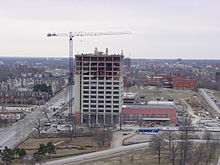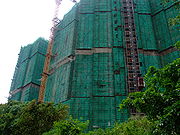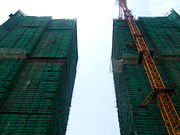- Construction
-
For other uses, see Construction (disambiguation).
In the fields of architecture and civil engineering, construction is a process that consists of the building or assembling of infrastructure. Far from being a single activity, large scale construction is a feat of human multitasking. Normally, the job is managed by a project manager, and supervised by a construction manager, design engineer, construction engineer or project architect.
For the successful execution of a project, effective planning is essential. involved with the design and execution of the infrastructure in question must consider the environmental impact of the job, the successful scheduling, budgeting, construction site safety, availability of building materials, logistics, inconvenience to the public caused by construction delays and bidding, etc.
Contents
Types of construction projects
 Construction of a prefabricated home
Construction of a prefabricated home
In general, there are three types of construction:
- Building construction
- Heavy / civil construction
- Industrial construction
Each type of construction project requires a unique team to plan, design, construct and maintain the project.
Building construction
Building construction is the process of adding structure to real property. The vast majority of building construction projects are small renovations, such as addition of a room, or renovation of a bathroom. Often, the owner of the property acts as laborer, paymaster, and design team for the entire project. However, all building construction projects include some elements in common - design, financial, estimating and legal considerations. Many projects of varying sizes reach undesirable end results, such as structural collapse, cost overruns, and/or litigation reason, those with experience in the field make detailed plans and maintain careful oversight during the project to ensure a positive outcome.
Commercial building construction is procured privately or publicly utilizing various delivery methodologies, including cost estimating, hard bid, negotiated price, traditional, management contracting, construction management-at-risk, design & build and design-build bridging.
Residential construction practices, technologies, and resources must conform to local building authority regulations and codes of practice. Materials readily available in the area generally dictate the construction materials used (e.g. brick versus stone, versus timber). Cost of construction on a per square meter (or per square foot) basis for houses can vary dramatically based on site conditions, local regulations, economies of scale (custom designed homes are always more expensive to build) and the availability of skilled tradespeople. As residential (as well as all other types of construction) can generate a lot of waste, careful planning again is needed here.
The most popular method of residential construction in the United States is wood framed construction. As efficiency codes have come into effect in recent years, new construction technologies and methods have emerged. University Construction Management departments are on the cutting edge of the newest methods of construction intended to improve efficiency, performance and reduce construction waste.
Industrial construction
Industrial construction, though a relatively small part of the entire construction industry, is a very important component. Owners of these projects are usually large, for-profit, industrial corporations. These corporations can be found in such industries as Infrastructure, Power Transmission & Distribution, metallurgical and material handling, medicine, petroleum, chemical, power generation, manufacturing etc. Processes in these industries require highly specialized expertise in planning, cost estimating, design, and construction. As in building and heavy/highway construction, this type of construction requires a team of individuals to ensure a successful project often undertaken by big construction companies.
Construction processes
Design team
 Shasta Dam under construction in June 1942
Shasta Dam under construction in June 1942
In the modern industrialized world, construction usually involves the translation of designs into reality. A formal design team may be assembled to plan the physical proceedings, and to integrate those proceedings with the other parts. The design usually consists of drawings and specifications, usually prepared by a design team including surveyors, civil engineers, cost engineers (or quantity surveyors), mechanical engineers, electrical engineers, structural engineers, fire protection engineers, planning consultants, architectural consultants, and archaeological consultants. The design team is most commonly employed by (i.e. in contract with) the property owner. Under this system, once the design is completed by the design team, a number of construction companies or construction management companies may then be asked to make a bid for the work, either based directly on the design, or on the basis of drawings and a bill of quantities provided by a quantity surveyor. Following evaluation of bids, the owner will typically award a contract to the most cost efficient bidder.
The modern trend in design is toward integration of previously separated specialties, especially among large firms. In the past, architects, interior designers, engineers, developers, construction managers, and general contractors were more likely to be entirely separate companies, even in the larger firms. Presently, a firm that is nominally an "architecture" or "construction management" firm may have experts from all related fields as employees, or to have an associated company that provides each necessary skill. Thus, each such firm may offer itself as "one-stop shopping" for a construction project, from beginning to end. This is designated as a "design Build" contract where the contractor is given a performance specification and must undertake the project from design to construction, while adhering to the performance specifications.
Several project structures can assist the owner in this integration, including design-build, partnering and construction management. In general, each of these project structures allows the owner to integrate the services of architects, interior designers, engineers and constructors throughout design and construction. In response, many companies are growing beyond traditional offerings of design or construction services alone and are placing more emphasis on establishing relationships with other necessary participants through the design-build process.
The increasing complexity of construction projects creates the need for design professionals trained in all phases of the project's life-cycle and develop an appreciation of the building as an advanced technological system requiring close integration of many sub-systems and their individual components, including sustainability. Building engineering is an emerging discipline that attempts to meet this new challenge.
Financial advisors
Construction projects can suffer from preventable financial problems. Underbids ask for too little money to complete the project. Cash flow problems exist when the present amount of funding cannot cover the current costs for labour and materials, and because they are a matter of having sufficient funds at a specific time, can arise even when the overall total is enough. Fraud is a problem in many fields, but is notoriously prevalent in the construction field[citation needed]. Financial planning for the project is intended to ensure that a solid plan with adequate safeguards and contingency plans are in place before the project is started and is required to ensure that the plan is properly executed over the life of the project.
Mortgage bankers, accountants, and cost engineers are likely participants in creating an overall plan for the financial management of the building construction project. The presence of the mortgage banker is highly likely, even in relatively small projects since the owner's equity in the property is the most obvious source of funding for a building project. Accountants act to study the expected monetary flow over the life of the project and to monitor the payouts throughout the process. Cost engineers and estimators apply expertise to relate the work and materials involved to a proper valuation. Cost overruns with government projects have occurred when the contractor was able to identify change orders or changes in the project resulting in large increases in cost, which are not subject to competition by other firm as they have already been eliminated from consideration after the initial bid.[1]
Large projects can involve highly complex financial plans and often start with a conceptual estimate performed by a consulting estimator. As portions of a project are completed, they may be sold, supplanting one lender or owner for another, while the logistical requirements of having the right trades and materials available for each stage of the building construction project carries forward. In many English-speaking countries, but not the United States, projects typically use quantity surveyors. In the United States construction estimating professionals like members of the American Society of Professional Estimators of the Consulting Estimators FORUM are typically employed.
Legal considerations
Main article: Construction law Construction along Ontario Highway 401, widening the road from six to twelve travel lanes.
Construction along Ontario Highway 401, widening the road from six to twelve travel lanes.
A construction project must fit into the legal framework governing the property. These include governmental regulations on the use of property, and obligations that are created in the process of construction.
The project must adhere to zoning and building code requirements. Constructing a project that fails to adhere to codes will not benefit the owner. Some legal requirements come from malum in se considerations, or the desire to prevent things that are indisputably bad - bridge collapses or explosions. Other legal requirements come from malum prohibitum considerations, or things that are a matter of custom or expectation, such as isolating businesses to a business district and residences to a residential district. An attorney may seek changes or exemptions in the law governing the land where the building will be built, either by arguing that a rule is inapplicable (the bridge design will not collapse), or that the custom is no longer needed (acceptance of live-work spaces has grown in the community).
A construction project is a complex net of contracts and other legal obligations, each of which must be carefully considered. A contract is the exchange of a set of obligations between two or more parties, but it is not so simple a matter as trying to get the other side to agree to as much as possible in exchange for as little as possible. The time element in construction means that a delay costs money, and in cases of bottlenecks, the delay can be extremely expensive. Thus, the contracts must be designed to ensure that each side is capable of performing the obligations set out. Contracts that set out clear expectations and clear paths to accomplishing those expectations are far more likely to result in the project flowing smoothly, whereas poorly drafted contracts lead to confusion and collapse.
Legal advisors in the beginning of a construction project seek to identify ambiguities and other potential sources of trouble in the contract structure, and to present options for preventing problems. Throughout the process of the project, they work to avoid and resolve conflicts that arise. In each case, the lawyer facilitates an exchange of obligations that matches the reality of the project.
Interaction of expertise
Design, finance, and legal aspects overlap and interrelate. The design must be not only structurally sound and appropriate for the use and location, but must also be financially possible to build, and legal to use. The financial structure must accommodate the need for building the design provided, and must pay amounts that are legally owed. The legal structure must integrate the design into the surrounding legal framework, and enforce the financial consequences of the construction process.
Procurement
Procurement describes the merging of activities undertaken by the client to obtain a building. There are many different methods of construction procurement; however the three most common types of procurement are:
- Traditional (Design-bid-build)
- Design and Build
- Management Contracting
There is also a growing number of new forms of procurement that involve relationship contracting where the emphasis is on a co-operative relationship between the principal and contractor and other stakeholders within a construction project. New forms include partnering such as Public-Private Partnering (PPPs) aka Private Finance Initiatives (PFIs) and alliances such as "pure" or "project" alliances and "impure" or "strategic" alliances. The focus on co-operation is to ameliorate the many problems that arise from the often highly competitive and adversarial practices within the construction industry.
Traditional
Main article: Design-bid-buildThis is the most common method of construction procurement and is well established and recognized. In this arrangement, the architect or engineer acts as the project coordinator. His or her role is to design the works, prepare the specifications and produce construction drawings, administer the contract, tender the works, and manage the works from inception to completion. There are direct contractual links between the architect's client and the main contractor. Any subcontractor will have a direct contractual relationship with the main contractor.
Design and build
Main article: Design-buildThis approach in Custom Home Construction has become more common in recent years in Orlando, FL, and involves the entire Custom Home Builder in the design/build process. The Custom Home Builder will be involved in all phases, early-on in the custom home build to ensure that the to complete an entire package for the customer. In some cases, the Design and Build (D & B) package can also include finding the site, arranging funding and applying for all necessary statutory consents.
The owner produces a list of requirements for a project, giving an overall view of the project's goals. Several D&B contractors present different ideas about how to accomplish these goals. The owner selects the ideas he likes best and hires the appropriate contractor. Often, it is not just one contractor, but a consortium of several contractors working together. Once a contractor (or a consortium/consortia) has been hired, they begin building the first phase of the project. As they build phase 1, they design phase 2. This is in contrast to a design-bid-build contract, where the project is completely designed by the owner, then bid on, then completed.
Kent Hansen, pointed out that state departments of transportation (DOTs) usually use design build contracts as a way of getting projects done when states don't have the resources. In DOTs, design build contracts are usually used for very large projects.[2]
Management procurement systems
Main article: Construction managementIn this arrangement the client plays an active role in the procurement system by entering into separate contracts with the designer (architect or engineer), the construction manager, and individual trade contractors. The client takes on the contractual role, while the construction or project manager provides the active role of managing the separate trade contracts, and ensuring that they all work smoothly and effectively together.
Management procurement systems are often used to speed up the procurement processes, allow the client greater flexibility in design variation throughout the contract, the ability to appoint individual work contractors, separate contractual responsibility on each individual throughout the contract, and to provide greater client control.
Authority having jurisdiction
See also: Planning permission Construction on a building in Kansas City, Missouri
Construction on a building in Kansas City, Missouri
In construction, the authority having jurisdiction (AHJ) is the governmental agency or sub-agency which regulates the construction process. In most cases, this is the municipality in which the building is located. However, construction performed for supra-municipal authorities are usually regulated directly by the owning authority, which becomes the AHJ.
During the planning of a building, the zoning and planning boards of the AHJ will review the overall compliance of the proposed building with the municipal General Plan and zoning regulations. Once the proposed building has been approved, detailed civil, architectural, and structural plans must be submitted to the municipal building department (and sometimes the public works department) to determine compliance with the building code and sometimes for fit with existing infrastructure. Often, the municipal fire department will review the plans for compliance with fire-safety ordinances and regulations.
Before the foundation can be dug, contractors are typically required to verify and have existing utility lines marked, either by the utilities themselves or through a company specializing in such services. This lessens the likelihood of damage to the existing electrical, water, sewage, phone, and cable facilities, which could cause outages and potentially hazardous situations. During the construction of a building, the municipal building inspector inspects the building periodically to ensure that the construction adheres to the approved plans and the local building code. Once construction is complete and a final inspection has been passed, an occupancy permit may be issued.
An operating building must remain in compliance with the fire code. The fire code is enforced by the local fire department.
Changes made to a building that affect safety, including its use, expansion, structural integrity, and fire protection items, usually require approval of the AHJ for review concerning the building code.
Construction careers
 Helicopter view of the Atacama Large Millimeter/submillimeter Array (ALMA) Operations Support Facility (OSF) construction site. Credit ESO.
Helicopter view of the Atacama Large Millimeter/submillimeter Array (ALMA) Operations Support Facility (OSF) construction site. Credit ESO.
There are many routes to the different careers within the construction industry which vary by country. However, there are three main tiers of careers based on educational background which are common internationally:
- Unskilled and Semi-Skilled - General site labour with little or no construction qualifications.
- Skilled - On-site managers whom possess extensive knowledge and experience in their craft or profession.
- Technical and Management - Personnel with the greatest educational qualifications, usually graduate degrees, trained to design, manage and instruct the construction process.
Skilled occupations in the UK require further education qualifications, often in vocational subject areas. These qualifications are either obtained directly after the completion of compulsory education or through "on the job" apprenticeship training. In the UK, 8500 construction-related apprenticeships were commenced in 2007.[3]
Technical and specialised occupations require more training as a greater technical knowledge is required. These professions also hold more legal responsibility. A short list of the main careers with an outline of the educational requirements are given below:[4]
- Architect - Typically holds 1, Undergraduate 3 year degree in architecture + 1, Post-Graduate 2 year degree (DipArch or BArch) in architecture plus 24 months experience within the industry. To use the title "architect" the individual must be registered on the Architects Registration Board register of Architects.
- Civil Engineer - Typically holds a degree in a related subject. The Chartered Engineer qualification is controlled by the Engineering council, and is often achieved through membership of the Institution of Civil Engineers. A new university graduate must hold a master's degree to become chartered, persons with bachelor's degrees may become an Incorporated Engineer.
- Building Services Engineer - Often referred to as an "M&E Engineer" typically holds a degree in mechanical or electrical engineering. Chartered Engineer status is governed by the Engineering Council, mainly through the Chartered Institution of Building Services Engineers.
- Project Manager - Typically holds a 4-year or greater higher education qualification, but are often also qualified in another field such as quantity surveying or civil engineering.
- Quantity Surveyor - Typically holds a master's degree in quantity surveying. Chartered status is gained from the Royal Institution of Chartered Surveyors.
- Structural Engineer - Typically holds a bachelors or master's degree in structural engineering, new university graduates must hold a master's degree to gain chartered status from the Engineering Council, mainly through the Institution of Structural Engineers.
In 2010 a salary survey revealed the differences in remuneration between different roles, sectors and locations in the construction and built environment industry.[5] The results showed that areas of particularly strong growth in the construction industry, such as the Middle East, yield higher average salaries than in the UK for example. The average earning for a professional in the construction industry in the Middle East, across all sectors, job types and levels of experience, is £42,090, compared to £26,719 in the UK.[6] This trend is not necessarily due to the fact that more affluent roles are available however as architects with 14 or more years experience working in the Middle East earns on average £43,389 per annum, compared to £40,000 in the UK.[6]
History
Main article: History of constructionSee also: History of architectureThe firsthuts and shelters, constructed by hand or with simple tools. As cities grew during the Bronze Age, a class of professional craftsmen, like bricklayers and carpenters, appeared. Occasionally, slaves were used for construction work. In the Middle Ages, these were organized into guilds. In the 19th century, steam-powered machinery appeared, and later diesel- and electric powered vehicles such as cranes, excavators and bulldozers. Modern-day Construction involves creating awesome structures that can show the beauty and creativity of the human intellect.
See also
- Index of construction articles
- List of construction trades
- Outline of construction
References
- ^ School districts increasingly seek alternate financing : North County Times - Californian
- ^ Cronin, Jeff (2005). "S. Carolina Court to Decide Legality of Design-Build Bids". Construction Equipment Guide. http://www.cegltd.com/story.asp?story=5592. Retrieved 2008-01-04.
- ^ ConstructionSkills – Apprenticeships
- ^ Careersadvice.direct.gov.uk
- ^ "UK website launches salary comparison tool". http://www.constructionweekonline.com/article-11582-uk-website-launches-salary-comparison-tool/. Retrieved 2011-07-04.
- ^ a b "Salary Benchmarker". http://salarybenchmarker.careerstructure.com/?WT.mc_id=B_A_EM_SB_GPR. Retrieved 2011-07-04.
Construction industry by country Categories:
Wikimedia Foundation. 2010.








